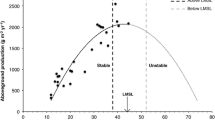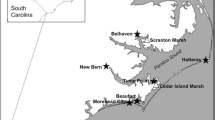Abstract
Foundation species structure environments and create refuge from environmental stress. In New England high salt marsh, the grass Spartina patens is a foundation species that reduces salinity, anoxia, desiccation, and thermal stresses through canopy shading and root proliferation. In a factorial S. patens-removal and warming field experiment, foundation species removal strongly impacted every aspect of the community, reiterating the important role of the foundation species S. patens in the high marsh. Given this central role, we hypothesized that facilitation by the foundation species would be even more important under warmer conditions by ameliorating more severe thermal stress. However, the ecological role of S. patens was unaffected by experimental warming, and, independent of the presence of the foundation species, warming had only weak effects on the salt marsh ecological community. Only the foundation species itself responded strongly to warming, by significantly increasing aboveground production in warmed plots. Apparently, amelioration of thermal stress is not as important for salt marsh ecosystem function as S. patens’ moderation of salinity and desiccation stresses. From these experimental results, we anticipate that climate change-associated thermal stress will not greatly affect S. patens-dominated high marsh communities. In contrast, foundation species loss, an emergent conservation issue in Atlantic salt marshes, represents a critical threat to salt marsh ecosystem function.




Similar content being viewed by others
References
Altieri AH, Silliman BR, Bertness MD (2007) Hierarchical organization via a facilitation cascade in intertidal cordgrass bed communities. Am Nat 169:195–206
Bertness MD (1991a) Interspecific interactions among high marsh perennials in a New England salt marsh. Ecology 72:125–137
Bertness MD (1991b) Zonation of Spartina patens and Spartina alterniflora in a New England salt marsh. Ecology 72:138–148
Bertness MD, Ellison AM (1987) Determinants of pattern in a New England salt marsh plant community. Ecol Monogr 57:129–147
Bertness MD, Ewanchuk PJ (2002) Latitudinal and climate-driven variation in the strength and nature of biological interactions in New England salt marshes. Oecologia 132:392–401
Bertness MD, Hacker SD (1994) Physical stress and positive association among marsh plants. Am Nat 144:363–372
Bertness MD, Leonard GH (1997) The role of positive interactions in communities: lessons from intertidal habitats. Ecology 78:1976–1989
Bertness MD, Silliman BR (2008) Consumer control of salt marshes driven by human disturbance. Conserv Biol 22:618–623
Bertness MD, Gough L, Shumway SW (1992) Salt tolerances and the distribution of fugitive salt marsh plants. Ecology 73:1842–1851
Booth DJ, Beretta GA (2002) Changes in a fish assemblage after a coral bleaching event. Mar Ecol Prog Ser 245:205–212
Bortolus A, Schwindt E, Iribarne O (2002) Positive plant–animal interactions in the high marsh of an Argentinean coastal lagoon. Ecology 83:733–742
Brewer JS, Bertness MD (1996) Disturbance and intraspecific variation in the clonal morphology of salt marsh perennials. Oikos 77:107–116
Bromberg Gedan K, Crain CM, Bertness MD (2009) Small-mammal herbivore control of secondary succession in New England tidal marshes. Ecology 90:430–440
Bruno JF, Bertness MD (2001) Habitat modification and facilitation in benthic marine communities. In: Bertness MD, Gaines SD, Hay ME (eds) Marine community ecology. Sinauer, Sunderland, pp 201–218
Bruno JF, Stachowicz JJ, Bertness MD (2003) Inclusion of facilitation into ecological theory. Trends Ecol Evol 18:119–125
Buckeridge KM, Jefferies RL (2007) Vegetation loss alters soil nitrogen dynamics in an Arctic salt marsh. J Ecol 95:283–293
Callaway RM et al (2002) Positive interactions among alpine plants increase with stress. Nature 417:844–848
Chapman VJ (1974) Salt marshes and salt deserts of the world, 2nd edn. Cramer, Lehre
Charles H, Dukes JS (2009) Effects of warming and altered precipitation on plant and nutrient dynamics of a New England salt marsh. Ecol Appl 19:1758–1773
Crain CM (2008) Interactions between marsh plant species vary in direction and strength depending on environmental and consumer context. J Ecol 96:166–173
Dayton PK (1972) Toward an understanding of community resilience and the potential effects of enrichments to the benthos at McMurdo Sound Antarctica. In: Parker BC (ed) Proceedings of the colloquium on conservation problems in Antarctica. Allen Press, Lawrence, pp 81–96
Dayton PK (1975) Experimental evaluation of ecological dominance in a rocky intertidal algal community. Ecol Monogr 45:137–159
Deutsch CA et al (2008) Impacts of climate warming on terrestrial ectotherms across latitude. PNAS 105:6668–6672
Ehleringer JR, Cerling TE, Helliker BR (1997) C4 photosynthesis, atmospheric CO2, and climate. Oecologia 112:285–299
Ellison AM et al (2005) Loss of foundation species: consequences for the structure and dynamics of forested ecosystems. Front Ecol Environ 3:479–486
Frumhoff PC, McCarthy JJ, Melillo JM, Moser SC, Wuebbles DJ (2007) Confronting climate change in the US Northeast: science, impacts, and solutions. Synthesis report of the Northeast Climate Impacts Assessment (NECIA). Union of Concerned Scientists, Cambridge, MA
Hacker SD, Gaines SD (1997) Some implications of direct positive interactions for community species diversity. Ecology 78:1990–2003
Harley CDG (2003) Abiotic stress and herbivory interact to set range limits across a two-dimensional stress gradient. Ecology 84:1477–1488
Holdredge C, Bertness MD, Altieri A (2009) Role of crab herbivory in die-off of New England salt marshes. Conserv Biol 23:672–679
Hollister RD, Webber PJ (2000) Biotic validation of small open-top chambers in a tundra ecosystem. Glob Change Biol 6:835–842
IPCC (ed) (2007) Climate change 2007: the physical science basis. Cambridge University Press, New York
Jones CG, Lawton JH, Shachak M (1997) Positive and negative effects of organisms as physical ecosystem engineers. Ecology 78:1946–1957
Kearney M, Shine R, Porter WP (2009) The potential for behavioral thermoregulation to buffer “cold-blooded” animals against climate warming. PNAS 106:3835–3840
Kirwan ML, Guntenspergen GR, Morris JT (2009) Latitudinal trends in Spartina alterniflora productivity and the response of coastal marshes to global change. Glob Change Biol 15:1982–1989
Klein JA, Harte J, Zhao X (2004) Experimental warming causes large and rapid species loss, dampened by simulated grazing, on the Tibetan Plateau. Ecol Lett 7:1170–1179
Leonard GH (2000) Latitudinal variation in species interactions: a test in the New England rocky intertidal zone. Ecology 81:1015–1030
Lorenzen CJ (1967) Determination of chlorophyll and pheo-pigments: spectrophotometric equations. Limnol Oceanogr 12:343–346
Ludlam JP, Shull DH, Buchsbaum (2002) Effects of haying on salt-marsh surface invertebrates. Biol Bull 203:250–251
Marion GM et al (1997) Open-top designs for manipulating field temperature in high-latitude ecosystems. Glob Change Biol 3(Suppl 1):20–32
Moore P, Hawkins SJ, Thompson RC (2007) Role of biological habitat amelioration in altering the relative responses of congeneric species to climate change. Mar Ecol Prog Ser 334:11–19
National Climatic Data Center (2003) US Climate normals, 1971–2000. National Climatic Data Center, Asheville
Oberbauer SF et al (2007) Tundra CO2 fluxes in response to experimental warming across latitudinal and moisture gradients. Ecol Monogr 77:221–238
Redfield AC (1972) Development of a New England salt marsh. Ecol Monogr 42:201–237
Shumway SW, Bertness MD (1992) Salt stress limitation of seedling recruitment in a salt marsh plant community. Oecologia 92:490–497
Smith SM (2009) Multi-decadal changes in salt marshes of Cape Cod, Massachusetts: a photographic analysis of vegetation loss, species shifts, and geomorphic change. North East Nat 16:183–208
Smith JR, Fong P, Ambrose RF (2006) Dramatic declines in mussel bed community diversity: response to climate change? Ecology 87:1153–1161
Somero GN (2005) Linking biogeography to physiology: evolutionary and acclimatory adjustments of thermal limits. Front Zool. doi:10.1186/1742-9994-1182-1181
Turner RE (1976) Geographic variations in salt marsh macrophyte production: a review. Contrib Mar Sci 20:47–68
Walker MD et al (2006) Plant community responses to experimental warming across the tundra biome. PNAS 103:1342–1346
Whitcraft CR, Levin LA (2007) Regulation of benthic algal and animal communities by salt marsh plants: impact of shading. Ecology 88:904–917
Zavaleta ES, Thomas BD, Chiariello NR, Asner GP, Shaw MR, Field CB (2003) Plants reverse warming effect on ecosystem water balance. PNAS 100:9892–9893
Acknowledgments
We would like to thank K. Raposa at the NBNERR for site coordination and temperature data, C. Holdredge and C. M. Crain for help in the field, and A. Altieri for helpful comments on the manuscript. This work was funded through EPA STAR and NERRS GRF funding to K. B. G. and RI Sea Grant funding to M. D. B. All research was in compliance with United States’ laws.
Author information
Authors and Affiliations
Corresponding author
Additional information
Communicated by Jon Keeley.
Rights and permissions
About this article
Cite this article
Gedan, K.B., Bertness, M.D. How will warming affect the salt marsh foundation species Spartina patens and its ecological role?. Oecologia 164, 479–487 (2010). https://doi.org/10.1007/s00442-010-1661-x
Received:
Accepted:
Published:
Issue Date:
DOI: https://doi.org/10.1007/s00442-010-1661-x




